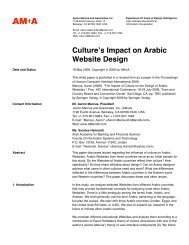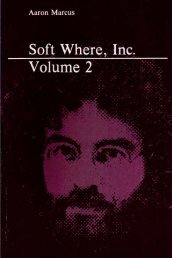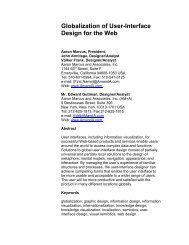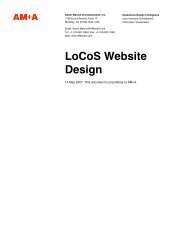AM+A.SciFi+HCI.eBook.17Aug12 - Aaron Marcus and Associates, Inc.
AM+A.SciFi+HCI.eBook.17Aug12 - Aaron Marcus and Associates, Inc.
AM+A.SciFi+HCI.eBook.17Aug12 - Aaron Marcus and Associates, Inc.
Create successful ePaper yourself
Turn your PDF publications into a flip-book with our unique Google optimized e-Paper software.
<strong>Aaron</strong> <strong>Marcus</strong>, The Past 100 Years of the Future, Page 16<br />
A typical taxonomy of HCI components that might be featured in sci-fi literature <strong>and</strong><br />
media might include focus on the following:<br />
Hardware<br />
Software<br />
User community<br />
Subject-matter content<br />
Metaphors<br />
Mental models<br />
Navigation<br />
Interaction<br />
Appearance<br />
In future studies of the relation of sci-fi to HCI, students may cross-tabulate that list with<br />
a typical taxonomy of the science-fiction literature, which might inclue the following:<br />
Genre<br />
Story narrative<br />
Technology<br />
Society<br />
Temporal view<br />
Culture<br />
Hardware<br />
Software<br />
Medium<br />
Cross-combining these terms provides a rich basis for future analysis of computerhuman<br />
interaction in science-fiction literature. The complexity should provide ample<br />
challenges to many future PhDs of literature, media, <strong>and</strong> the HCI community.<br />
What is particularly interesting is focusing on the visual works of science-fiction cinema<br />
(<strong>and</strong> videos), because the world of cinema generally requires the filling out of a scene<br />
with the appropriate <strong>and</strong> necessary props to complete a compelling picture of the future,<br />
assuming we are not considering some abstract, symbolic cinema in which such iconic,<br />
pictographic, <strong>and</strong> photographic detail might not be required.<br />
Written literature can focus more easily on inner thoughts as well as some physical<br />
details; movies show motion. Movies must show “all” of the backgound, or we<br />
immediately sense a disjoint or incomplete, uncompelling scene.<br />
These media depict motion of people <strong>and</strong> things against a backgound. In sci-fi media,<br />
action is primary, followed by the story, <strong>and</strong> people/personalities, at least as a general<br />
rule. Sci-fi movie makers, from the beginning, were compelled by the medium to show<br />
HCI, because these visual media required people to “fill out” a scene with approriate<br />
props to complete a compelling picture of the future. Sci-fi movie- <strong>and</strong> video-makers<br />
were, in effect, rapid prototypers from the start, among the first user-centered, userexperience<br />
designers of HCI. One other difference between written literature <strong>and</strong> these<br />
visual media: sci-fi authors would have to create names for new technologies, products,<br />
16






